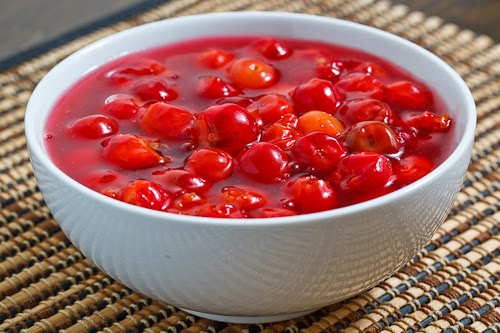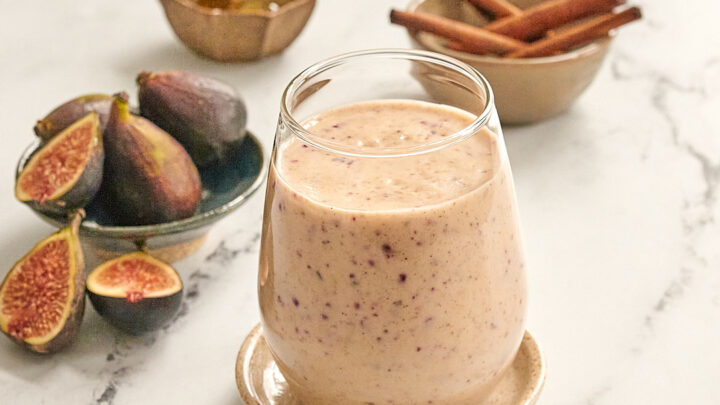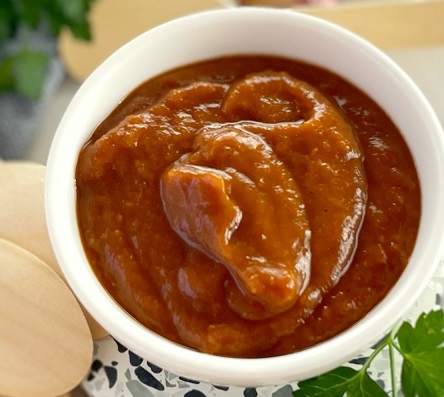Image | Title | Ratings | Link |
 | Orange Chocolate Mousse | 5/5 | |
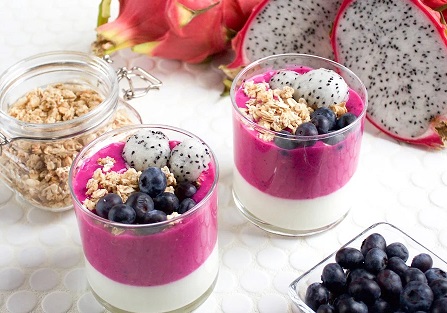 | Dragon Fruit Parfait | 5/5 |
Mango Chutney
Mango chutney is a versatile, sweet, and tangy condiment that pairs beautifully with a variety of dishes, from Indian curries to grilled meats or even a cheese platter.
This delicious condiment is made by simmering ripe mangoes with sugar, spices, and vinegar to create a thick, flavorful chutney that’s packed with complex flavors.
Ingredients:
- 4 large ripe mangoes (about 4 cups diced)
- 1 cup (200g) granulated sugar
- 1 cup (240ml) apple cider vinegar or white vinegar
- 1 medium onion, finely chopped
- 1 tablespoon grated fresh ginger
- 2 garlic cloves, minced
- 1 teaspoon mustard seeds
- 1 teaspoon cumin seeds
- 1 teaspoon ground turmeric
- ½ teaspoon ground cinnamon
- ½ teaspoon ground cloves
- ½ teaspoon chili flakes or fresh chopped chili (adjust to taste)
- 1 teaspoon salt
- ½ cup (80g) raisins (optional)
Equipment:
- Large pot or Dutch oven
- Paring knife
- Potato masher (optional)
- Sterilized jars with lids for storage
- Wooden spoon
- Clean cloth for wiping jar rims
Step 1: Prepare the Mangoes
Start by choosing ripe, sweet mangoes for the chutney. The mangoes should be slightly soft to the touch, with vibrant orange flesh. If your mangoes are too firm, you may not get the right sweetness, and if they’re overripe, they can turn mushy during cooking.
Peel the mangoes and cut the flesh away from the pit. Dice the mangoes into bite-sized pieces. If you prefer a chunkier chutney, leave the pieces larger; for a smoother chutney, dice the mangoes smaller. Place the diced mangoes in a bowl and set them aside.
Step 2: Prepare the Spice Base
In a large pot or Dutch oven, heat a tablespoon of oil over medium heat. Add the mustard seeds and cumin seeds, and let them sizzle for about 30 seconds, stirring constantly. The mustard seeds will begin to pop, releasing their aromatic oils. Be careful not to let the seeds burn, as this can make the chutney bitter.
Next, add the finely chopped onions to the pot and cook them until they turn translucent, about 5–7 minutes. Stir in the grated ginger and minced garlic, cooking for another 2 minutes until fragrant.
Step 3: Add the Mangoes and Spices
Once the onions, ginger, and garlic are softened, add the diced mangoes to the pot. Stir them into the onion mixture, ensuring the mangoes are well-coated in the spices.
Now, it’s time to add the dry spices. Sprinkle in the turmeric, ground cinnamon, ground cloves, chili flakes (or fresh chopped chili), and salt. Stir everything together to combine the spices evenly with the mangoes.
Step 4: Add Vinegar and Sugar
Pour the apple cider vinegar (or white vinegar) into the pot. The vinegar provides the tangy backbone of the chutney and acts as a preservative. Stir in the granulated sugar, which will help balance the acidity of the vinegar and bring out the natural sweetness of the mangoes.
As the sugar dissolves, it will create a syrupy liquid that helps to thicken the chutney as it cooks. If you want to add extra texture and sweetness, stir in the raisins at this stage. They will plump up and absorb the flavors of the chutney as it simmers.
Image | Title | Ratings | Link |
 | Grilled Pineapple Skewers | 5/5 | |
 | Berry Parfait | 5/5 |
Step 5: Simmer the Chutney
Once all the ingredients are combined, bring the mixture to a gentle boil, then reduce the heat to low and let the chutney simmer uncovered for about 45 minutes to an hour. Stir the chutney occasionally to prevent it from sticking to the bottom of the pot. The chutney will gradually thicken and darken in color as it cooks.
The goal is to cook off the excess liquid, leaving you with a thick, spoonable chutney. If you prefer a smoother chutney, you can use a potato masher to break down the mango pieces as they soften, but leaving it chunky gives the chutney more texture.
Step 6: Check for Doneness
The chutney is ready when it has reduced to a thick, jam-like consistency and the mango pieces have softened completely. Taste the chutney and adjust the seasoning, adding more salt, sugar, or chili flakes as needed. If the chutney is too thick, you can add a splash of water to loosen it up.
Step 7: Sterilize and Fill Jars
While the chutney is simmering, sterilize your jars to ensure the chutney is safely preserved. Wash the jars and lids in hot, soapy water, then boil them in water for 10 minutes. Let the jars dry on a clean towel.
Once the chutney is done, carefully spoon it into the sterilized jars, leaving about ¼ inch of space at the top. Wipe the rims of the jars with a clean cloth to ensure a proper seal. Screw the lids on tightly.
Step 8: Store and Enjoy
If you’re planning to store the chutney for a longer period, process the filled jars in a water bath for 10 minutes. This will create a vacuum seal that preserves the chutney for up to a year. Once the jars are sealed, store them in a cool, dark place.
If you’re going to eat the chutney within a few weeks, you can skip the water bath and simply store the jars in the refrigerator.
Tips for Serving:
Pairing: Mango chutney pairs beautifully with curries, grilled meats, sandwiches, and cheese platters. It also makes a great topping for roasted vegetables.
Spice Variations: Adjust the heat level by adding more or less chili. You can also experiment with spices like cardamom, coriander, or fennel for a unique twist.
This homemade mango chutney is a perfect combination of sweet, tangy, and spicy, and it’s a delicious way to preserve the flavors of summer. Enjoy!
Thanks for visiting Fruits Recipes
Image | Title | Ratings | Link |
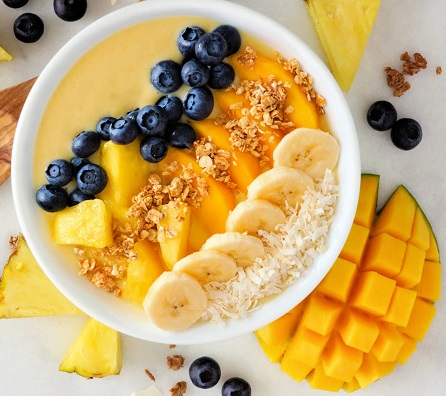 | Mango Smoothie Bowl | 5/5 | |
 | Apple Pie | 5/5 | |
 | Chicken with Lemon and Olives | 5/5 | |
 | Strawberry Banana Smoothie | 5/5 |

